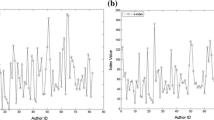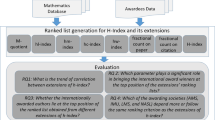Abstract
Quantitative evaluation of scientists now has become very important at many aspects in the range of nation, even all over the world. Among the indices used for quantitative evaluation, h-type indicators are the most popular right now. However, because of the problem that mastering more than 40 variants is difficult and time-consuming, we need an intuitional and quick method by which we can present these indicators for evaluators and those even with little knowledge regarding to h-type indicators. In this paper, we introduce the paper-citation histogram in which most h-type indicators could be illustrated with their geometrical interpretation. With the help of these plots, evaluators can better understand the indices in a relatively short time. Meanwhile the geometrical interpretation can provide an insight into the research achievements of scientists.









Similar content being viewed by others
References
Abramo, G. & DAngelo, C. (2011). Evaluating research: From informed peer review to bibliometrics. Scientometrics 87(3), 499–514.
Abramo, G. & DAngelo, C. (2011). National-scale research performance assessment at the individual level. Scientometrics 86(2), 347–364.
Alonso, S., Cabrerizo, F., Herrera-Viedma, E. & Herrera, F. (2009). h-index: A review focused in its variants, computation and standardization for different scientific fields. Journal of Informetrics 3(4), 273–289.
Alonso, S., Cabrerizo, F., Herrera-Viedma, E. & Herrera, F. (2010). hg-index: A new index to characterize the scientific output of researchers based on the h-and g-indices. Scientometrics 82(2), 391–400.
Bornmann, L., Mutz, R. & Daniel, H. (2008). Are there better indices for evaluation purposes than the h index? a comparison of nine different variants of the h index using data from biomedicine. Journal of the American Society for Information Science and Technology 59(5), 830–837.
Braun, T., Bergstrom, C., Frey, B., Osterloh, M., West, J., Pendlebury, D. & Rohn, J. (2010). How to improve the use of metrics. Nature 465(17), 870–872.
Cabrerizo, F., Alonso, S., Herrera-Viedma, E. & Herrera, F. (2010). q2-index: Quantitative and qualitative evaluation based on the number and impact of papers in the hirsch core. Journal of Informetrics 4(1), 23–28.
Carbó-Dorca, R. (2010). A monodimensional scientific performance measure: the h index, can be substituted by simple multidimensional descriptors? Journal of mathematical chemistry 47(1), 548–550.
Costas, R. & Bordons, M. (2007). The h-index: Advantages, limitations and its relation with other bibliometric indicators at the micro level. Journal of Informetrics 1(3), 193–203.
Costas, R. & Bordons, M. (2008). Is g-index better than h-index? an exploratory study at the individual level. Scientometrics 77(2), 267–288.
Egghe, L. (2006). Theory and practise of the g-index. Scientometrics 69(1), 131–152.
Egghe, L. (2010). The hirsch index and related impact measures. Annual review of information science and technology 44(1), 65–114.
Hirsch, J. (2005). An index to quantify an individual’s scientific research output. In: Proceedings of the National Academy of Sciences of the United states of America 102(46), 16,569.
Jin, B. (2006). H-index: an evaluation indicator proposed by scientist. Science Focus 1(1), 8–9.
Jin, B. (2007). The ar-index: complementing the h-index. ISSI newsletter 3(1):6.
Jin, B., Liang, L., Rousseau, R. & Egghe, L. (2007). The r-and ar-indices: Complementing the h-index. Chinese science bulletin 52(6), 855–863.
Kelly, C. & Jennions, M. (2006). The <i> h index </i> and career assessment by numbers. Trends in Ecology & Evolution 21(4), 167–170.
Kosmulski, M. (2006). A new hirsch-type index saves time and works equally well as the original h-index. ISSI newsletter 2(3), 4–6.
Microsoft: http://academic.research.microsoft.com/.
Rousseau, R. (2006). New developments related to the hirsch index.
Schreiber, M. (2008). To share the fame in a fair way, hm modifies h for multi-authored manuscripts. New Journal of Physics 10, 040,201.
Sidiropoulos, A., Katsaros, D. & Manolopoulos, Y. (2007). Generalized hirsch h-index for disclosing latent facts in citation networks. Scientometrics 72(2), 253–280.
Zhang, C. (2009). The e-index, complementing the h-index for excess citations. PLoS One 4(5), e5429.
Acknowledgments
This work was under Grand by the Natural Science Foundation of China (No. U1233110), and the Fundamental Research Funds for the Central Universities (No. DUT10JR06).
Author information
Authors and Affiliations
Corresponding author
Rights and permissions
About this article
Cite this article
Liu, Y., Zuo, W., Gao, Y. et al. Comprehensive geometrical interpretation of h-type indices. Scientometrics 96, 605–615 (2013). https://doi.org/10.1007/s11192-012-0916-1
Received:
Published:
Issue Date:
DOI: https://doi.org/10.1007/s11192-012-0916-1




